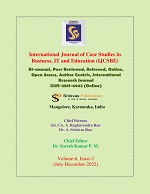Amazon's Artificial Intelligence in Retail Novelty - Case Study
Main Article Content
Abstract
Purpose: The provision of a method for thoughtful decision-making is the core purpose of artificial intelligence research and development. The primary goal of artificial intelligence (AI) is to give computers the ability to do intellectual tasks such as making decisions, solving problems, seeing their surroundings, and understanding human communication. Amazon is famous for using robots—roughly 30,000 of them—within its distribution centres. The company has gained mechanical autonomous organisation, which allows the robots to function independently. Kiva in 2012. Retailers can improve their demand estimates, make better pricing decisions, and optimise product placement with the aid of AI. The end result is that customers are connected with the proper products at the suitable time, in the appropriate place, and at the appropriate price. Utilizing predictive analytics may assist in determining the amount of a product that should be ordered to ensure that shops do not end up with either an excess or a shortage of inventory.
Design/Methodology/Approach: The efficiency of our workplaces may be substantially improved by the use of artificial intelligence. When AI is utilised to do tasks that are boring or dangerous, human workers are given more time to concentrate on endeavours that need capabilities such as creativity and empathy, amongst other abilities. Artificial intelligence (AI) may be of assistance to a corporation in three different areas: the automation of corporate processes; the acquisition of insight through data analysis; and the interaction with consumers and staff.
Findings/Result: As a result of AI, individuals will be freed up to focus on the 20% of non-routine jobs that account for 80% of the value they create. In the future, "intelligent automation of process change" (IAPC) will be used by smart machines to constantly examine and improve the whole process of a business's response to artificial intelligence. Automated and optimised everyday chores save your time and money and improves operational efficiency and productivity. The outputs of cognitive technology may help you make quicker business judgments and benefits the AI in the Workplace. Doing the same thing over and over again might take a toll on your workers' productivity. Automating and optimising these procedures will save you money. Employees will be able to concentrate on multiple areas at once, resulting in increased production. As AI processes data more quickly than humans, this leads to increased productivity.
Originality/Value: It is essential to have a deeper comprehension of the differences between AI and human intelligence if we are to be adequately prepared for a society in which AI will play a much more pervasive role in our everyday lives in the foreseeable future. The process of reproduction is intricately connected to both biological and human intelligence. The advancement of artificial intelligence (AI) is significant for the reason that it paves the way for software to perform human activities and cost-effective than it was previously possible.
Paper Type: Company Analysis.
